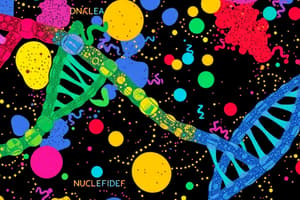Podcast
Questions and Answers
What are the basic components of nucleotides?
What are the basic components of nucleotides?
A nitrogenous base, a five-carbon sugar, and a phosphate functional group.
Which of the following nitrogenous bases are found in DNA?
Which of the following nitrogenous bases are found in DNA?
- Uracil (U)
- Cytosine (C) (correct)
- Adenine (A) (correct)
- Thymine (T) (correct)
What sugars are present in nucleotides?
What sugars are present in nucleotides?
Ribose and deoxyribose.
What is the difference between a nucleotide and a nucleoside?
What is the difference between a nucleotide and a nucleoside?
Nucleic acids are formed by nucleotides linked through phosphodiester bonds.
Nucleic acids are formed by nucleotides linked through phosphodiester bonds.
What is the structural description of DNA?
What is the structural description of DNA?
What are complementary base pairs in DNA?
What are complementary base pairs in DNA?
DNA is separated into 46 pieces called chromosomes.
DNA is separated into 46 pieces called chromosomes.
What is the role of messenger RNA (mRNA)?
What is the role of messenger RNA (mRNA)?
What facilitates the translation process in protein synthesis?
What facilitates the translation process in protein synthesis?
What occurs during transcription?
What occurs during transcription?
What is a mutation?
What is a mutation?
What are common sources of mutations?
What are common sources of mutations?
What is a virus?
What is a virus?
What is HIV?
What is HIV?
What is recombinant DNA technology?
What is recombinant DNA technology?
What is cloning?
What is cloning?
Flashcards are hidden until you start studying
Study Notes
Components of Nucleic Acids
- Nucleic acids are composed of nucleotides, each containing a nitrogenous base, a five-carbon sugar, and a phosphate group.
- Nucleic acids form from sequences of four types of nucleotides.
Nitrogen Bases
- Four nitrogenous bases are involved: adenine (A), guanine (G), thymine (T), and cytosine (C) in DNA; uracil (U) replaces thymine in RNA.
- Bases fall into two categories: purines (A and G) and pyrimidines (T, C, and U).
Ribose and Deoxyribose
- Nucleotides include ribose in RNA and deoxyribose in DNA, distinguished by a prime symbol to indicate nucleotide carbon positions.
Naming Nucleotides
- Nucleotides are named by combining the nucleoside name (sugar + nitrogenous base) with the number of phosphate groups.
- Abbreviations indicate the sugar type (d for deoxyribose) and the base.
Nucleic Acid Formation
- Nucleic acids are formed by linking nucleotides via phosphodiester bonds between the 3′ and 5′ carbons of adjacent sugars.
DNA Structure
- DNA sequences encode cellular proteins; Chargaff's rules establish base pairing (A = T and G = C).
- DNA's double helix structure was modeled by Watson and Crick in 1953, with antiparallel strands and complementary base pairing (A-T, G-C).
Chromosomes
- DNA compacts into 46 chromosomes through supercoiling around histone proteins, with human DNA stretching about 6 feet when fully extended.
Messenger RNA and Transcription
- Transcription creates mRNA from a DNA template; RNA polymerase synthesizes mRNA that is complementary to the DNA strand.
Ribosomal RNA and the Ribosome
- Ribosomes consist of rRNA and proteins, decoding mRNA to produce proteins; mRNA aligns with ribosome subunits during translation.
Transfer RNA and Translation
- tRNA transports specific amino acids to ribosomes, featuring a three-base anticodon that pairs with mRNA codons, ensuring accurate protein synthesis.
Protein Synthesis Steps
- Transcription: DNA unwinds, and mRNA forms before traveling to the ribosome.
- Translation: mRNA directs tRNA to assemble amino acids into proteins, starting with the start codon AUG.
Termination of Protein Synthesis
- Protein synthesis concludes when a stop codon is reached; the polypeptide chain is released and may require folding for functionality.
Genetic Mutations
- Mutations involve changes in DNA sequences, affecting protein sequences and functions; most DNA does not encode proteins, limiting impact.
Sources of Mutations
- Errors during DNA replication can lead to spontaneous mutations; environmental mutagens like sodium nitrate can induce changes.
- Germ cell mutations can pass to offspring, potentially causing genetic diseases.
Viruses
- Viruses, containing nucleic acid and a protective capsid, need host cells to replicate; they commandeer cellular machinery to produce more viral particles.
HIV-1 and AIDS
- HIV is a retrovirus attacking T4 lymphocytes, weakening the immune response; therapies aim to disrupt the viral life cycle.
Recombinant DNA Technology
- Involves splicing genes from different organisms to produce desired proteins; uses plasmids as vectors for gene incorporation and expression.
Nuclear Transplantation - Cloning
- Cloning creates genetically identical organisms by inserting somatic cell nuclei into enucleated egg cells; Dolly the sheep was the first cloned mammal, born in 1996.
Studying That Suits You
Use AI to generate personalized quizzes and flashcards to suit your learning preferences.




